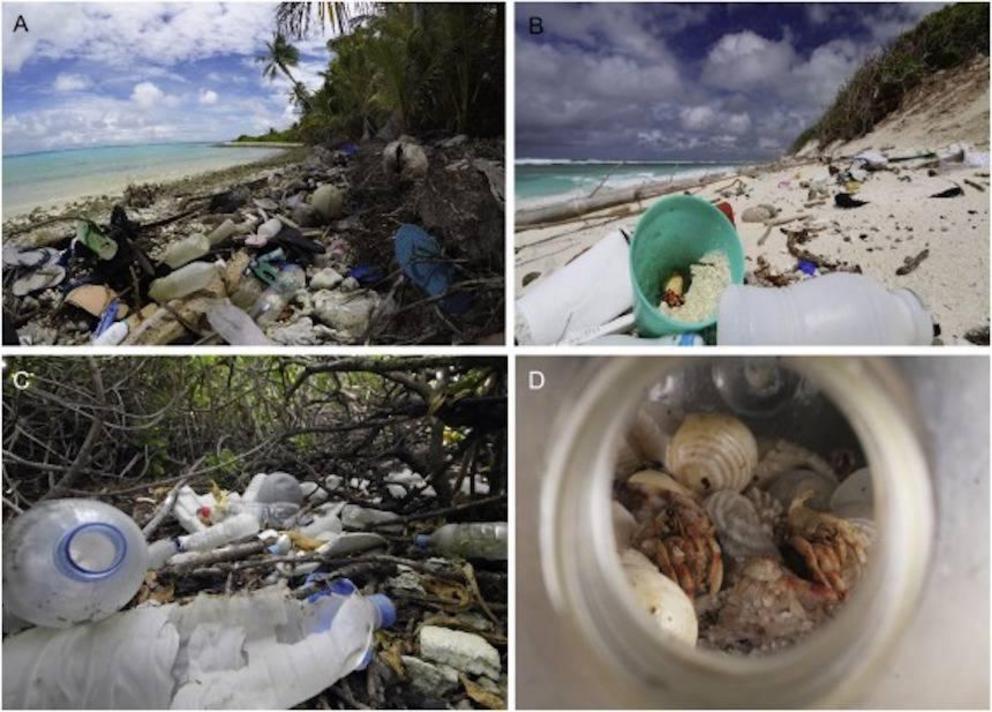Rampant death for hermit crabs who confuse plastic trash for shells
New research finds that on just two remote islands alone, nearly 600,000 crabs are killed every year by plastic debris.
If you have ever witnessed the true wonder of a hermit crab housing exchange, you know how crucial their seashell dwellings are. One of life's main missions for the hermit crab is to find increasingly bigger shells to call home as the crab itself grows. They can not live long without a shell to house their more vulnerable parts.
It's already (surprisingly) complicated enough, as you can see in the video at the bottom here. But what happens when a crab's habitat is littered with copious amounts of plastic trash and bottles? As researchers have found in a new study looking at the problem, it is nothing short of carnage.
“It’s not quite a domino effect. It’s almost like an avalanche,” said Alex Bond from London’s Natural History Museum, which assisted in the study. “Hermit after hermit going into these bottles thinking they’ll get their next home, when in reality, it’s their last home.”
The study was conducted by Dr. Jennifer Lavers, a researcher with the University of Tasmania’s Institute for Marine and Antarctic Studies, and her team and took place on two islands; the Cocos (Keeling) Islands in the Indian Ocean and the Henderson Island in the Pacific.
Previously, Lavars had documented the plastic trash on both islands. On the Cocos, with a population of 600 people and located about 1,300 miles off the coast of Western Australia, they found 414 million pieces of garbage, most of it plastic. They found 373,000 toothbrushes and 977,000 shoes, for which it would take the population of Cocos 4,000 years to create on their own. And they also noticed something else.
“When we were surveying debris on the islands, I was struck by how many open plastic containers contained hermit crabs, both dead and alive,” Lavers said.
So with that plethora of plastic in mind, the team decided to "investigate the potential for beach debris to disrupt terrestrial species and ecosystems" on the two remote islands, according the study.
And the findings were beyond dismal: "Around 61,000 and 508,000 crabs are estimated to become entrapped in debris and die each year on Henderson Island and the Cocos (Keeling) Islands, respectively."
The crabs in question are strawberry hermit crabs (Coenobita perlatus), and as the study explains, they use the odor of other dead crabs to scope out available shells. Once one has crawled into a plastic container and becomes trapped, it eventually dies and attracts more to the trap.
"...entrapments occur on a regular basis and conspecific attraction, the very mechanism that evolved to ensure hermit crabs could replace their shells, has resulted in a lethal lure," note the authors.

(A) accumulated plastic debris creates an obstacle for crabs on the beaches of the Cocos (Keeling) Islands. (B) a hermit crab inside a green bucket along the high tide of South Island. (C) accumulated plastic debris in the beach-back vegetation on West Island. (D) crabs that became trapped and died inside a plastic drink bottle that washed up on Cocos.

(A) a strawberry hermit crab navigates through natural and anthropogenic debris on East Beach, Henderson Island. (B) accumulated debris on East Beach, Henderson Island. (C) 526 hermit crabs trapped inside a single container on Henderson Island in June 2019. (D) some of the 526 hermit crab shells from the container shown in panel (C).
“It is inevitable that these creatures will interact with and be affected by plastic pollution, although ours is one of the first studies to provide quantitative data on such impacts,” said Lavars. She added that since marine plastic is a global problem, comparable hermit crab losses on a worldwide scale would have significant implications for ecosystems.
“High concentrations of debris are now being encountered on beaches around the world, many of which are also home to hermit crabs that can be expected to interact with plastic pollution in the same way as those we studied," she said
“Hermit crabs play a crucial role in the health of tropical environments by aerating and fertilising soil, and dispersing seeds and removing detritus, as well being a key part of the marine ecosystem," she added, noting that the population degradation has economic implications as well in terms of hurting fishing and tourism.
If there's a bright side to this depressing mess, it's that, as far as the crabs are concerned, at least beach cleanups could be helpful.
“This is a perfect opportunity for those who were thinking about getting involved,” she said. “It’s not just removing plastic from the beach because it’s unsightly, but it’s potentially doing a lot for hermit crab populations."
Lavars also said that changing attitudes about plastic are important as well. Shopping with reusable bags and giving up plastic straws, for example, are both easy and quick for those who can.
“They’re not going to dig us out of this, but they’re still worthwhile,” she said. “So get the bamboo toothbrush and feel good about it.”
The research was published in the Journal of Hazardous Materials.
And now, a BBC video about hermit crabs swapping shells, it is so good:
Video can be accessed at source link below.

